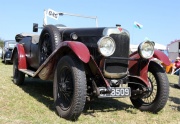Lea-Francis: Cars


































Note: This is a sub-section of Lea-Francis
of Lower Ford Street, Coventry.
1903 They branched out into car manufacture. Lea-Francis built cars, under licence, for the Singer company.
1904 February. Details of their petrol car.[1]
1902 August. Details of a trial of the 12-hp car.[2]
1905 February. Details of their 16 hp car.[3]
In 1919 they started to build their own cars from bought in components.
From 1922 Lea-Francis had a tie up with Vulcan of Southport, sharing manufacturing and dealers. Vulcan supplied bodies to Lea-Francis and in return got gearboxes and steering gear. The association finished in 1928 when Vulcan stopped making cars.
1925 A sporting image began to appear from about 1925, leading to models such as the Hyper and the Ace of Spades. The Hyper (also called the S Type) was the first British supercharged production car with a 1.5 litre Meadows engine.
In 1928 a Lea-Francis Hyper won the Ulster TT, a 13.5 mile race on the roads of Northern Ireland in the hands of legendary race car driver, Kaye Don. The race was watched by a record 250,000 spectators, and the victory placed Lea-Francis firmly on the map.
1937 The 12-hp and the 14-hp were introduced in 1937 and continued until the start of the war in 1939, when production ceased and the factory concentrated on manufacturing for the war effort.
1946 Post-war car production commenced in 1946 with updated vehicles based on the pre-war designs. The 14-hp Saloon and Sports were luxurious and sporty vehicles, and were popular, if expensive. Eventually, a more powerful 2 1/2 litre engine and improved chassis with independent front suspension and hydraulic brakes were introduced across the range.
1951 Exhibitor at the 1951 Motor Show in the Car Section.
A total of almost 10,000 Lea-Francis vehicles were made until production ceased after the 1960 Lea-Francis Lynx failed to capture the buying public's attention. The Lea-Francis name and the assets of the company were purchased by Barrie Price who continues to provide service and spares for the surviving cars, and has also built a number of "modern" Lea-Francis motor cars reviving the model name Ace of Spades.
See Also
- Lea-Francis: 12
- Lea-Francis: 14
- Lea-Francis: 1.5-Litre
- Lea-Francis: 2.5-Litre Sports
- Lea-Francis: 18 H.P. Saloon
Sources of Information
- [1] Wikipedia
- British Motor Cars 1950/51

